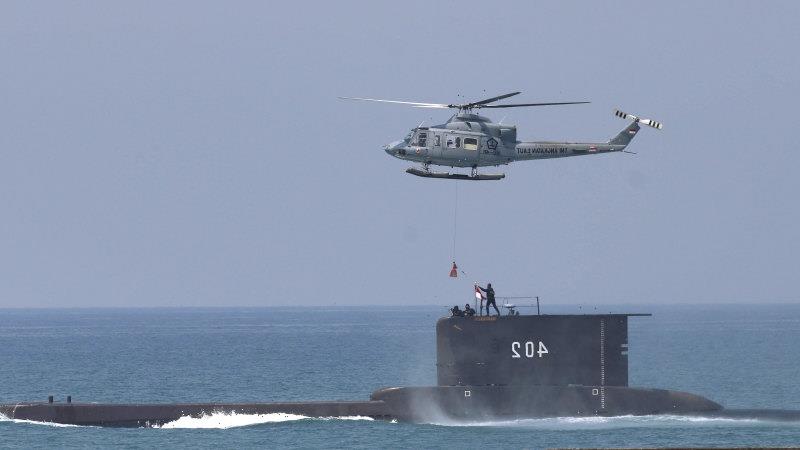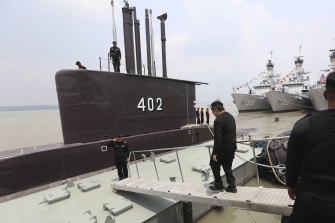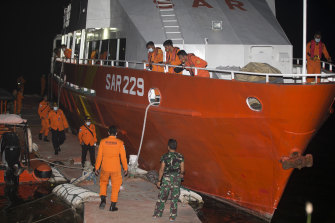Singapore: Indonesia was on Thursday night holding out hope of finding the KRI Nanggala-402 submarine that disappeared off the coast of Bali after the discovery of a mystery floating object beneath the surface.
But time is running out for the 53 crew aboard because the oxygen supply is due to last only until Saturday.
Singapore and Malaysia have joined the multinational search and rescue effort, however their vessels are not due to arrive at least until the weekend.
An oil spill was found near the site where the KRI Nanggala-402 submarine, pictured in 2014, was last located.Credit:AP
The Indonesian navy lost contact with the 42-year-old German-built vessel at 3am on Wednesday local time [6am AEST] after it set off on a dive while taking part in a training exercise.
Officials said the submarine has a maximum operating depth of 500 metres but believed it may have sunk 600 to 700 metres. AP quoted an official from South Korea’s Daewoo Shipbuilding saying it would collapse beyond 200 metres.
Former submariners said an emergency evacuation could not be carried out if the vessel was in too deep.
The Indonesian navy said no contact had been made with the crew but it hoped a sonar finding on Thursday afternoon could lead to the submarine with the help of an echo sounder being installed on a warship in the area.
“What we found today is a high magnetism at a point within 50 to 100 metres deep and it’s floating,” Navy chief Admiral Yudo Margono said. “We hope it is the KRI Nanggala.
“The oxygen supply in a blackout condition that we predict is sufficient for 72 hours or three days. So it lost contact at 3am yesterday and will last until Saturday at 3am. Hopefully, it can be immediately found before that so that oxygen supply is still available.”
An Indonesian search and rescue crew launches from Benoa harbor in Bali. Credit:AP
Owen said this mode of escape could be achieved via the submarine’s air-locked tower. A free ascent – “where you flood the whole submarine and everybody would get out as quick as they could” – was possible from about 60 metres.
Navy spokesman First Admiral Julius Widjojono told The Sydney Morning Herald and The Age that Indonesia did not have its own submarine salvage equipment and two rescue ships, Singapore’s MV Swift and Malaysia’s Mega Bakti, were on their way. But he said the Singaporean ship would not arrive in the area until at least Saturday and the Malaysian vessel would not get there until Monday.
The Indonesian navy said Australia was also providing assistance but it was unclear how. Australia’s own submarine rescue system is managed by James Fisher Defence Australia and based in Western Australia.
Defence Minister Peter Dutton said he had spoken to his counterpart, Prabowo Subianto, to offer assistance.
“But the only reports that I can confirm at the moment are those that are public – and that is: [it] looks like, obviously, a terrible tragedy and it’s in a very deep part of waters – 700 or 800 metres deep potentially – and it makes it very difficult for the recovery,” Dutton said on Sydney’s 2GB radio.
But authorities still hoped the submarine may have merely been out of contact due to a communications malfunction.
The Singaporean MV Swift comes equipped with an eight-bed high-dependency ward, a re-compression chamber for 40 people and a helipad. However, its submersible DSAR 6 rescue craft can only dive 500 metres.
Singapore Minister for Defence Ng Eng Hen said the MV Swift was being dispatched “as fast as she could get ready”.
Michael Shoebridge, director of the Australian Strategic Policy Institute’s defence, strategy and national security program, said “this is a situation where time is critical”.
“Accidents involving submarines on the sea floor are some of the most horrific and human situations to deal with because surviving at that depth for any length of time is pretty tenuous and rescuing people from that kind of depth is just technically really hard,” he said.
“This is a situation where time is critical. It’s got all the hallmarks of a really tragic event.”
Senator Rex Patrick, a former submariner, expressed concern about the plight of the crew but was glad the Australian government had agreed to help.
“When these sorts of events happen submariners around the world – even though they’re in competing navies – are one,” he said.
What in the World
A note direct from our foreign correspondents about what’s making headlines around the world. Sign up for our weekly newsletter here.
Most Viewed in World
From our partners
Source: Read Full Article


